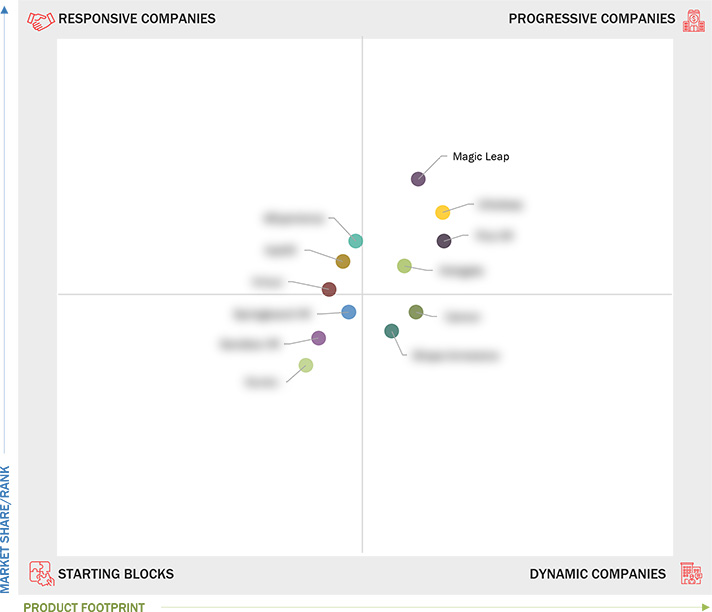Comparing 12 vendors in Location-based Entertainment Startups across 0 criteria.
The location-based entertainment (LBE) market is rapidly growing, driven by advancements in technologies like Virtual Reality, Augmented Reality, and Mixed Reality. These innovations enable immersive, interactive experiences that merge physical and digital environments. With rising consumer spending power and a growing preference for experiences over material possessions, the demand for LBE offerings is steadily increasing.
Market Leadership Quadrant
1.1 Study Objectives
1.2 Market Definition
1.2.1 Inclusions and Exclusions
1.3 Market Scope
1.3.1 Market Segmentation
1.3.2 Years Considered
1.4 Currency Considered
1.5 Stakeholders
1.6 Summary of Changes
2.1 Introduction
2.2 Market Dynamics
2.2.1 Drivers
2.2.1.1 Rising consumer spending power
2.2.1.2 Advancements in VR and AR technologies
2.2.1.3 Integration of artificial intelligence (AI) and machine
learning (ML) technologies
2.2.1.4 Rising demand for social and shared experiences
2.2.2 Restraints
2.2.2.1 Limited scalability of location-based entertainment business
2.2.2.2 High upfront cost
2.2.2.3 Impact of wealth dependency
2.2.3 Opportunities
2.2.3.1 Increase in live events and performances
2.2.3.2 Rising popularity of wearables such as fitness trackers and
smartwatches
2.2.3.3 Collaboration with brands & events
2.2.4 Challenges
2.2.4.1 Regulatory requirements at local, state, and federal levels
2.2.4.2 Rapid pace of technological change
2.2.4.3 Limited appeal
2.3 Brief History of Location-based Entertainment
2.4 Ecosystem Analysis
2.5 Regulatory Landscape
2.6 Supply Chain Analysis
2.7 Market Segmentation Overview
2.8 Consumer Behavior and Preferences
2.9 Technology Analysis
2.9.1 Key Technologies
2.9.1.1 Virtual Reality (VR)
2.9.1.2 Augmented Reality (AR)
2.9.1.3 Projection Mapping
2.9.2 Complementary Technologies
2.9.2.1 Artificial intelligence (AI) / Machine learning (ML)
2.9.3 Adjacent Technologies
2.9.3.1 Wearable devices
2.9.3.2 Cloud computing
2.10 Patent Analysis
2.11 Porter’s Five Forces Analysis
2.11.1 Threat of New Entrants
2.11.2 Threat of Substitutes
2.11.3 Bargaining Power of Suppliers
2.11.4 Bargaining Power of Buyers
2.11.5 Intensity of Competitive Rivalry
2.12 Trends/Disruptions Impacting Customer Business
2.13 Market Sizing Assumptions
2.14 Key Conferences and Events, 2025–2026
2.15 Technology Roadmap for Location-based Entertainment Market
2.15.1 Short-Term Roadmap (2023–2025)
2.15.2 Mid-Term Roadmap (2026–2028)
2.15.3 Long-Term Roadmap (2029–2030)
2.16 Best Practices in Location-based Entertainment Market
2.16.1 Seamless Integration of Technology
2.16.2 Personalization of Experiences
2.16.3 Focus on Hygiene and Safety
2.16.4 Scalability of Infrastructure
2.17 Current and Emerging Business Models
2.17.1 Pay-Per-Experience Model
2.17.2 Subscription Model
2.17.3 Partnership & Licensing Model
2.17.4 Freemium Model
2.17.5 Data Monetization
2.18 Location-based Entertainment Market: Tools, Frameworks, and Techniques
2.19 Trade Analysis
2.19.1 Export Scenario of Video Game Consoles, Machines, and Other
Articles for Funfair, Table, or Parlor
Games (HS Code 9504)
2.19.2 Import Scenario of Video Game Consoles, Machines, and Other
Articles for Funfair, Table, or Parlor
Games by Key Country, 2016–2023 (USD Billion)
2.20 Investment and Funding Scenario
2.21 Impact of Generative AI on Location-based Entertainment Market
2.21.1 Top Use Cases and Market Potential
2.21.1.1 Key Use Cases
2.21.2 Best Practices
2.21.2.1 Hospitality & tourism
2.21.2.2 Retail & shopping malls
2.21.2.3 Sports & live entertainment
2.21.3 Case Studies of Generative AI Implementation
2.21.3.1 AI-powered virtual tour guide enhancing visitor engagement
2.21.3.2 Smart AI concierge improving guest satisfaction in theme
parks
2.21.3.3 AI-generated gamified retail experience boosting foot
traffic in shopping malls
2.21.4 Client Readiness and Impact Assessment
2.21.4.1 Client A: Powered personalized storytelling
2.21.4.2 Client B: Intelligent virtual assistants & concierges
2.21.4.3 Client C: AI-driven gamification
3.1 Introduction
3.2 Key Player Strategies/Right to Win
3.3 Revenue Analysis
3.4 Market Share Analysis
3.5 Market Ranking Analysis
3.6 Brand Perception and Differentiation
3.7 Company Evaluation Matrix: Startups/SMEs
3.7.1 Progressive Companies
3.7.2 Responsive Companies
3.7.3 Dynamic Companies
3.7.4 Starting Blocks
3.7.5 Competitive Benchmarking: Startups/SMEs
3.8 Competitive Scenario and Trends
3.8.1 Product Launches
3.8.2 Deals
3.9 Brand/Product Comparison Analysis
3.10 Company Valuation and Financial Metrics of Key Location-based Entertainment Market Providers
4.1 SPRINGBOARDVR
4.1.1 Business overview
4.1.2 Products/Solutions/Services offered
4.1.3 Recent developments
4.2 4EXPERIENCE
4.2.1 Business overview
4.2.2 Products/Solutions/Services offered
4.2.3 Recent developments
4.3 HOLOGATE
4.3.1 Business overview
4.3.2 Products/Solutions/Services offered
4.3.3 Recent developments
4.4 ULTRALEAP
4.4.1 Business overview
4.4.2 Products/Solutions/Services offered
4.4.3 Recent developments
4.5 MAGIC LEAP
4.5.1 Business overview
4.5.2 Products/Solutions/Services offered
4.5.3 Recent developments
4.6 SHAPE IMMERSIVE
4.6.1 Business overview
4.6.2 Products/Solutions/Services offered
4.6.3 Recent developments
4.7 CAMON
4.7.1 Business overview
4.7.2 Products/Solutions/Services offered
4.7.3 Recent developments
4.8 KATVR
4.8.1 Business overview
4.8.2 Products/Solutions/Services offered
4.8.3 Recent developments
4.9 VIRTUIX
4.9.1 Business overview
4.9.2 Products/Solutions/Services offered
4.9.3 Recent developments
4.10 PICO
4.10.1 Business overview
4.10.2 Products/Solutions/Services offered
4.10.3 Recent developments
4.11 ILLUMIX
4.11.1 Business overview
4.11.2 Products/Solutions/Services offered
4.11.3 Recent developments
4.12 SANDBOX VR
4.12.1 Business overview
4.12.2 Products/Solutions/Services offered
4.12.3 Recent developments


 FOX4KC.com
FOX4KC.com
 Sep 2025
Sep 2025

